
Serbia is heavily dependent on avocado imports so as to meet local demand. Its moderately continental climate of cold winters and warm summers is not suitable for avocado production. The average rainfall is around 700mm per year and temperatures can be as low as 0°C and as high as 28°C.
Majority of the avocados sold in Serbia are found in supermarkets and hypermarkets. The largest number of consumers in the country is found in the cities of Belgrade, Nis and Novi Sad. Smaller retail outlets, wholesale markets and street vendors around Serbia also trade in a smaller quantities of avocados.
Serbia Avocado Imports
Imports of avocado in Serbia were valued at almost 8.5 million US Dollars in 2023. Compared to the previous year, it is an increase of 36%. The sharpest climb was from 2018 to 2019 when the import value rose from about 1 million US Dollars to around 2 million US Dollars.
Here are the total values in import of avocados in Serbia between 2012 and 2023.

Avocado Price in Serbia per kg
The cost of a kilo of avocados in Serbia can be between 350 Serbian dinar (US3.15 dollars) and 450 Serbian dinar (US4.04 dollars). This is based on the average import price per kg. This wholesale price has gone as low as 320 Serbian dinar (US2.88 dollars) in the recent past.
Retail prices of avocado per piece vary from seller to seller. Serbians can buy imported avocados for a better part of the year because they are sourced from several nations in different hemispheres. Market timing also determines the price range as late season avocados get a premium over early season avocados.
Avocado consumers in Serbia can also find either good discounts or higher prices depending on the time of shopping. Being a seasonal fruit, avocado prices are adjusted based on supply. Serbia imports majority of avocado during their summer months from June up to mid-September. It brings in small amounts of avocado the rest of the year from countries whose season comes later.
Avocado in Serbia
Serbia can be considered a high-value avocado market. The country takes in commercial varieties such as Hass and Fuerte. But it also brings in non-commercial green skin varieties. Many avocado consumers in Serbia prefer Hass avocados that are small in size because of their lower cost.
Consumers can expect to pay more for Hass avocados than the other varieties. Large avocados are still sold in the local market. Such kind of avocados are usually part of the trade and make up a small part of the regular shipments.
The logistical costs that come with importing avocados are a major factor in setting their retail prices. The closer the exporting country is to Serbia, the cheaper the price for the consumer. Avocados exported to Serbia are packed in both 4kg and 10kg cartons.
Avocado imports have to first go through the Customs Administration of Serbia. They are then tested using certain food safety protocols set by the Ministry of Health. The government of Serbia sets the requirements for importers of horticultural produce like avocado through the Ministry of Agriculture, Forestry and Water Management (MAFWM).
Cartons of avocado must be labeled according to guidelines determined by the Ministry of Trade, Tourism and Telecommunication. Bilingual language, which includes Serbian, is required on the label. Labels must include the following information:
- Name and address of producer
- Brand or trademark
- Country of origin
- Type of avocado and grade
- Storage instructions and temperature requirements
- Gross weight and number of avocados per carton
- Shelf life
- Harvest year and packing date
Avocados imported in Serbia must undergo the pesticide maximum residue level (MRL) tests done by government laboratories. They should not exceed acceptable limits according to Codex. MAFWM is responsible for the control of pesticides residue on avocado imports.

